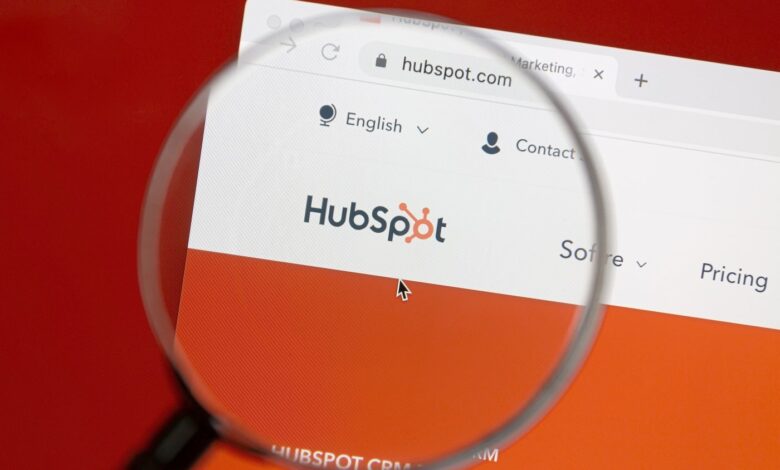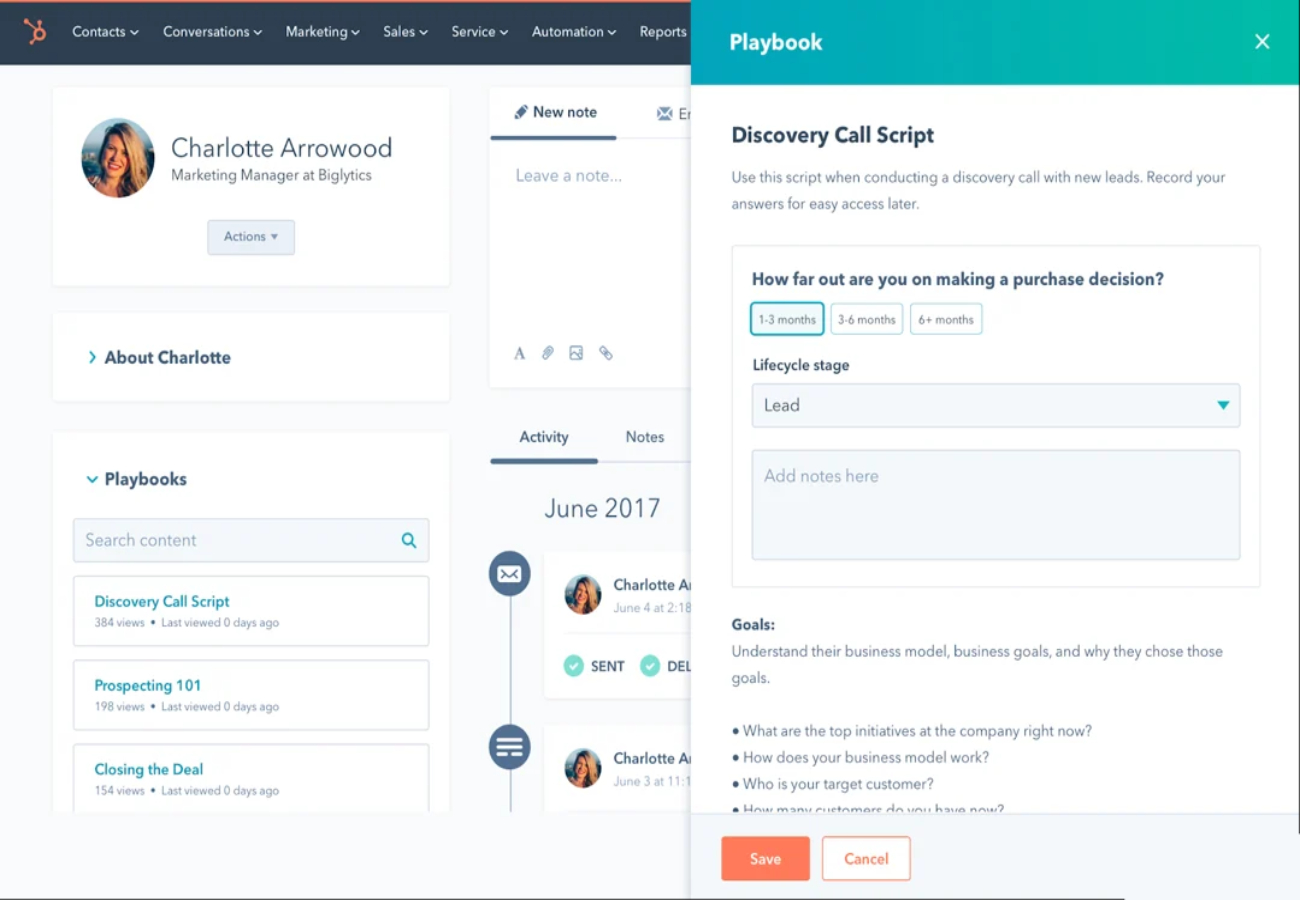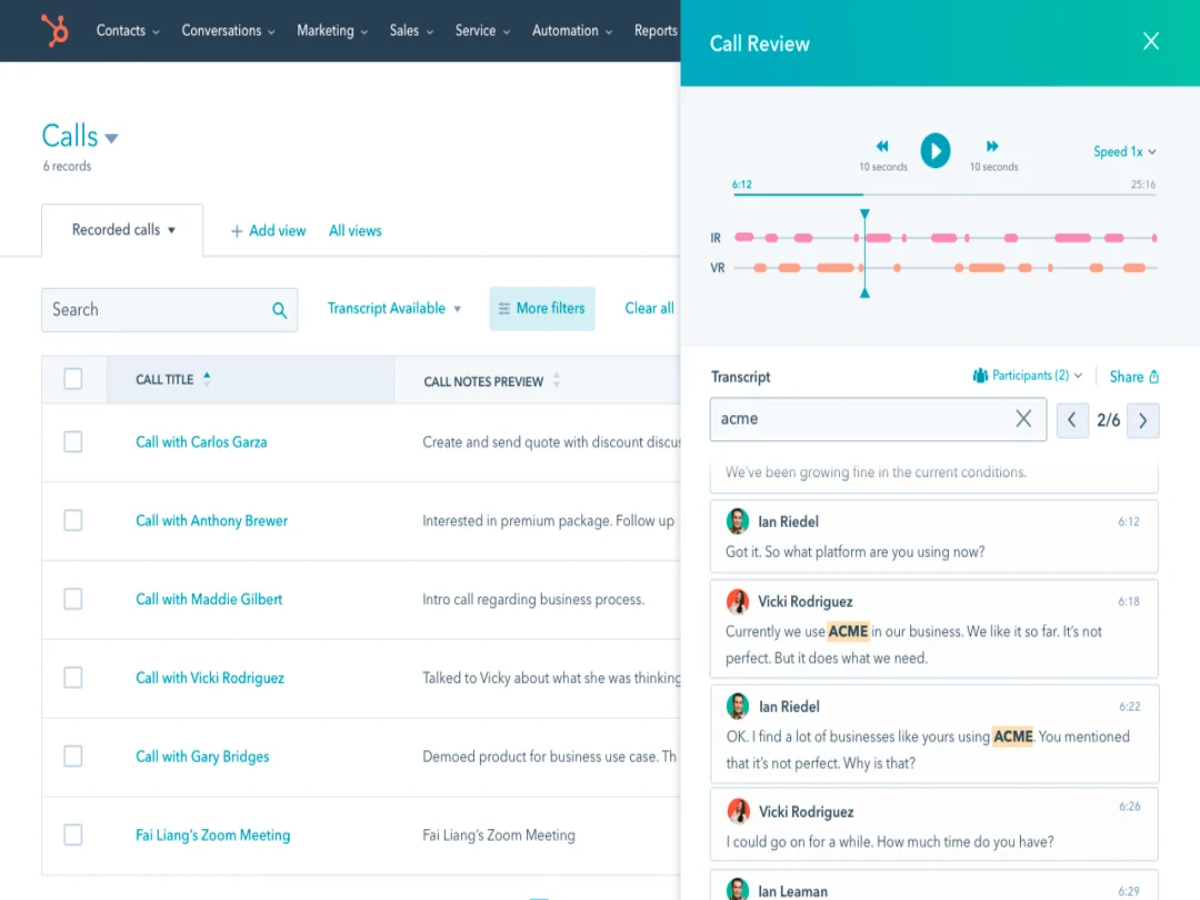Features, Pricing, Pros & Cons

HubSpot’s fast factsOur star rating: 4/5 Pricing: Robust free version for up to 2,500 users. Paid tiers start at $15 per seat per month when billed annually. Key features:
|
HubSpot is a popular customer relationship management platform with robust free and paid features to help streamline entire sales and marketing strategies. HubSpot’s custom pipelines and activity tracking make it easily scalable to fit any organization’s sales and customer management needs.
HubSpot continues to be a top scoring CRM with customer support and integration capabilities, but if you’re needing software with more advanced technology and reporting features, there are other options available.
Pricing
- Free CRM: Free for up to 2,500 users with contact management, quotes, live chat and more.
- Sales Hub Starter: $15 per seat per month, billed annually, or $20 when billed monthly.
- Sales Hub Professional: $90 per seat per month, billed annually, or $100 when billed monthly and one-time $1,500 onboarding fee.
- Sales Hub Enterprise: $150 per seat per month, with an annual commitment and one-time $3,500 onboarding fee.
SEE: For more details about HubSpot’s offerings and pricing, check out HubSpot’s Product and Services Catalog.
Key features of HubSpot
Call tracking
HubSpot’s call tracking system allows users to place and record client calls directly from the browser platform. This ensures each call is automatically logged and tracked to the correct customer profile (Figure A). This feature can also prioritize outbound calls, so sales reps can have their daily call schedule prepared for them to start dialing and selling sooner.
Sales playbooks
HubSpot’s sales playbooks software is a tool to equip sales reps with interactive sales plays, scripts, guides and more (Figure B). Playbooks are customizable to the user’s organization and selling style. They also provide real sales data from structured notes and multiple choice questions and answers.

Conversation intelligence
HubSpot’s conversation intelligence is an advanced feature that tracks sales reps performance on customer calls and provides coaching tips with data driven insights (Figure C). This feature doesn’t require users to switch dialing software or waste time training on a new calling service. Conversation intelligence can be applied to calls using HubSpot’s calling tool, Zoom, JustCall, Kixie and more.

Sales analytics and reporting
Users can choose from dozens of pre-made report styles or customize their own to view business analytics. The reports can display pipeline revenue, individual sales progress or target attainment. HubSpot’s analytic feature allows admin users to monitor sales activities and then create unique coaching insights (Figure D).

PREMIUM: Explore a full CRM feature comparison.
HubSpot pros and cons
| Pros | Cons |
|---|---|
|
|
Alternatives to HubSpot
There are limitations with HubSpot’s dashboard and pipeline customization, as well as how costly its higher support tiers and add-ons can be. Because of this, there are alternatives that offer similar core features in their free tiers with additional technology features like Pipedrive, Zoho CRM and Salesforce.
When researching the right CRM for your organization, first consider the budget allocated to such an investment, if the software specializes in your industry or if the software is scalable to meet the size and needs of your business.
DOWNLOAD: Compare the top CRMs for small businesses.
| Software | HubSpot CRM | Pipedrive | Zoho CRM | Salesforce |
|---|---|---|---|---|
| Custom dashboards | Limited | Yes | Limited | Yes |
| Native integrations | Yes | Yes | Yes | Yes |
| Third party integrations | Yes | Yes | Yes | Yes |
| AI-powered features | Yes | Yes | Yes | Yes |
| Free trial | No | 14 days | 15 days | 30 days |
| Starting price* | Free starting price | $14.90 per user per month | Free starting price | $25 per user per month |
* Pricing details are based on annual subscription rates. Different rates may apply for per-month billing.
Pipedrive
Pipedrive is a user-friendly CRM known for its visual pipelines to help simplify sales processes. Pipedrive is a great option if you’re looking for sales-focused software without any additional marketing tools. Though it doesn’t have a free-for-life version, Pipedrive’s starting price is still competitive.
SEE: For a closer look, check out this detailed comparison of Pipedrive and HubSpot.
Zoho CRM
Zoho CRM offers both sales and marketing features, similar to HubSpot. Zoho CRM does place a greater priority on social media marketing and online lead generation. The platform itself is easy to navigate and offers more advanced data and forecasting features compared to HubSpot.
SEE: For more details, explore this in-depth review of Zoho.
Salesforce
Salesforce is a cloud-based CRM software made especially for enterprise-sized sales teams. Users can create a variety of custom CRM reports that display analytics and sales forecasts in real time. Salesforce can sync and integrate with over 7,000+ apps, such as Mailchimp, DocuSign and Slack.
SEE: For more details, explore this in-depth review of Salesforce.
Review methodology
In order to review HubSpot and its offerings, we used our inhouse rubric of criteria we defined as most important when evaluating general CRM software. Next, we compared Hubspot against industry standards in that scoring tool. We relied on HubSpot’s own online resources in addition to real user feedback and scores.
Below is the breakdown of the criteria used to score HubSpot:
- Cost: Weighted 25% of the total score.
- Core features: Weighted 25% of the total score.
- Customizations: Weighted 15% of the total score.
- Integrations: Weighted 15% of the total score.
- Ease of use: Weighted 10% of the total score.
- Customer support: Weighted 10% of the total score.



